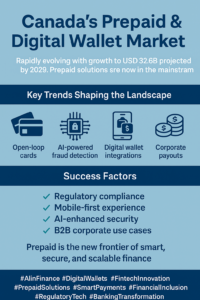 Canada’s Prepaid Card market is healthy and growing. GlobeNewswire pegs the 2025 numbers at USD 26.26 billion and likely to reach USD 32.61 Billion by 2029.
Canada’s Prepaid Card market is healthy and growing. GlobeNewswire pegs the 2025 numbers at USD 26.26 billion and likely to reach USD 32.61 Billion by 2029.
Among the Prepaid Card varieties, General-Purpose Reloadable (GPR) Cards (largely MasterCard, Visa and Amex) are the leaders in daily use (about 50% market share), while Gift Cards are seen to dominate in retail. Travel Cards fill in the gaps. The Prepaid Card industry is seen to to be reshaped by digital wallet integration, challenger fintechs, and inclusion-focused strategies. The outlook forecasts an increasing consumer choice, rising fintech-market share, and layered partnerships between traditional and digital-first players.
On the other hand, the Gift Card market is projected at USD 8.43B in 2025, up from USD 7.84B in 2024, with a strong CAGR of ~8% during 2020–2024 and continuing at ~6.5% through 2029, according to Businesswire. Amazon Canada is seen to be at the number one position in the Gift Card space.
While the Prepaid Card market is subject to regulation and consumer protection requirements (e.g., KYC, FINTRAC / AML, CDIC, Data Protection & Privacy), the Gift Card market is largely driven by the Issuing Retailer without any strict rules and regulations.
Either way, both the Prepaid Card market and the Gift Card market are “volume games” that require deep and long term investments, coupled with sustainable technology strategies to retain market spots. So, what is changing?
- New changes introduced in the financial services industry such as open banking, financial inclusion and fintect expansion to offer competing products have given rise to increasing regulatory and technology risks, and are compelling higher investments in infrastructure, outreach and customer experience dimensions, with investments in technology infrastructure dominating the arena to support contact less payments and to offer higher levels of security against cyber risks.
- Prepaid cards have evolved from being merely “Gift Cards” into core financial instruments, especially in use cases such as underbanked segments, offline payments, expense reimbursements and other non-regular types of financial transaction. For companies, it is simpler to manage issuance of Prepaid Cards as against running an expensive and full payroll process in these contexts.
- Card products and branding between financial institutions and fintech companies are becoming a blur, as card products work seamlessly across various apps, POS terminals, and mobile wallets. A couple of names in this space include KOHO and EQ Bank. This is an area where fintech companies are seen to having an edge over financial institutions due to their use of superior technology (read AI-driven), agility and speed of operations.
- Crypto-backed solutions have become the latest innovations.
- Payment Service Providers (PSPs) in Canada are now required to register with the Bank of Canada for oversight and system-level monitoring. This is in addition to the Code of Conduct for the Payment Card Industry in Canada that focuses on clearer fee disclosures and merchant rights, and the need to meet Payments Canada’s operational resilience, secure clearing / settlement, and interoperability standards.
What are the opportunities?
Several opportunities are evident to propel the future of Prepaid Cards.
- Expansion of Fintech companies in the Prepaid Cards space mainly targetted towards underbanked and digitally native consumers, by offerings through feature-rich prepaid products.
- Development and implementation of AI-driven Enterprise-grade prepaid solutions.
- Demand for virtual issuance, tokenization, and secure APIs that create opportunities for technology infrastructure providers.
- Enhanced credit risk modeling and customer profiling using the rich data stored and processed by the Prepaid Cards business.
- Enhanced customer experience by combining related businesses such as open banking and mortgages.
- Leverage AI for fraud detection, spending insights, and user engagement.
- Embedding Prepaid Card products in digital banking offerings.
Selective list of Risks and Challenges:
Where opportunities exist, risks tag along!
- Competition will drive pricing. Managing and operating on thinner margins to balance competition with operational costs is a key success facror.
- Transparency through Fee disclosures will influence customer relationship and retention stratgies.
- Addressing consumer preference and loyalty between Big Wallet providers versus financial institutions will determine market share between technologically advanced fintechs and traditional financial institutions. Customer demographics and tech-savvy meturity are key drivers.
- Ensuring compliance with complex regulatory requirements across multiple regions and geographies is expensive and will have a profound impact on reputation and financial profiles of the players involved.
Takeaways
Prepaid cards are evolving into smart, embedded financial tools. No longer just plastic value-holders. Key yardsticks will be:
- The ease with which Prepaid Cards will integrate with wallets.
- Their ability for multiple use cases in both personal and commercial environments.
- Their compabibility with multiple platforms and ease of mobility.
- Their acceptance by a wide range of people demographics.
AI will undoubtedly lead these transformations through automated and enhanced fraud detection, on-the-fly KYC and compliance measurement, credit scoring (where required), personalizing offers and product features, enabling the correct customer segmentation and ensuring prompt and quick service and support.
This era is of fintech companies and financial institutions building lasting synergies, collaborating and building card ecosystems and ensuring the end customers are provided with excellent services and products. The most promising prepaid ventures will be those that combine:
- Regulatory readiness (e.g, KYC, AML, PSP registration).
- Mobile and digital wallet integration.
- AI-powered innovation in UX, security, and analytics.
About This Article
This article is compiled by Financial Technology Frontiers, based on its industry research and developments in the Payment Cards Industry. Written in an accessible format, this article’s aim is to raise awareness about developments in the Payments industry, globally. FTF’s objective is to enable both financial service providers and technology companies take benefit from this article and ponder over their respective programs to support this change.
About Financial Technology Frontiers
Financial Technology Frontiers (FTF) is a global media-led fintech platform dedicated to building and nurturing innovation ecosystems. We bring together thought leaders, financial institutions, fintech disruptors, and technology pioneers to drive meaningful change in the financial services industry.
What you can do:
Connect and engage with us to share your interesting stories that you wish to showcase.
Partner with us to access markets globally, generate thought leadership content and conduct meaningful conversations with leaders in the financial services space.




